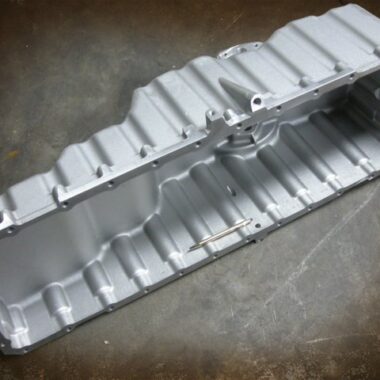Accuracy in Practice: The Art About Aluminum Casting
Accuracy in Practice: The Art About Aluminum Casting
Blog Article
Opening the Prospective of Aluminum Spreading: Proven Methods for Success
Aluminum casting has actually long been acknowledged for its convenience and widespread applications across numerous industries. Join us as we check out the essential elements that can drive light weight aluminum casting in the direction of unmatched success in today's competitive market landscape.
Advantages of Light Weight Aluminum Spreading
Light weight aluminum casting uses a multitude of advantages that make it a recommended choice in different commercial applications. One of the main advantages of light weight aluminum spreading is its light-weight nature, which adds to fuel performance in sectors such as automotive and aerospace. Additionally, aluminum is extremely malleable, enabling complex and elaborate shapes to be quickly created with spreading processes. This flexibility in style is a considerable benefit for markets that call for parts with details geometries.
In addition, aluminum casting offers superb rust resistance, making it optimal for applications where exposure to harsh settings is a worry. The material additionally shows good thermal conductivity, which is advantageous for sectors needing heat dissipation, such as electronic devices (about aluminum casting). Moreover, aluminum is totally recyclable, lining up with the expanding emphasis on lasting methods in modern production.
Style Factors To Consider for Casting
The layout phase plays an important duty in the overall success of a light weight aluminum spreading project. One essential factor to consider is the option of appropriate geometries and functions that assist in the spreading procedure.
Additionally, considerations connected to parting lines, gating systems, and risers are vital to avoid flaws like porosity and contraction. It is crucial to optimize the design for effective material usage and reduce post-processing demands. Simulations and prototyping can be useful devices in refining the casting and assessing style before full-blown production.
Partnership between style foundries, producers, and designers is vital to resolve any kind of possible difficulties early in the style phase. By including these factors to consider into the casting layout procedure, producers can enhance item top quality, decrease costs, and inevitably open the full possibility of light weight aluminum casting.
Enhancing Casting Performance
When aiming to boost casting efficiency in light weight aluminum casting jobs,Designing with an emphasis on optimizing product flow and lessening defects is crucial. To achieve this, making use of simulation software can aid in identifying possible problems prior to the spreading process starts. By simulating the circulation of liquified aluminum, developers can readjust gating and riser designs to make sure correct filling and solidification, inevitably decreasing the event of problems such as porosity or contraction.
Furthermore, applying proper warm therapy procedures can enhance the overall casting effectiveness. Warmth therapy can aid improve the mechanical residential or commercial properties of the light weight aluminum Read Full Report spreading, ensuring that the final component satisfies the needed requirements. Furthermore, utilizing automation and robotics in the spreading process can improve manufacturing, reduce hands-on labor, and boost total performance.
Furthermore, continuous tracking and high quality control throughout the spreading procedure are crucial for identifying any type of variances and making sure that the end products satisfy the preferred requirements. By carrying out these methods, makers can improve casting effectiveness, enhance product quality, and ultimately achieve better success in light weight aluminum spreading projects.
Quality Control in Aluminum Spreading

Efficient top quality control techniques play a crucial duty in making certain the accuracy and dependability of aluminum casting processes. Quality control actions in light weight aluminum spreading include a range of activities intended at maintaining certain requirements and identifying deviations that can endanger the final product.
Along with procedure control, high quality control in aluminum spreading includes rigorous screening and assessment procedures at various phases of manufacturing. Non-destructive testing approaches like ultrasonic screening and X-ray evaluation aid find interior defects without endangering the stability of the cast elements. Visual examinations, dimensional measurements, and mechanical screening additionally guarantee that the actors parts fulfill the needed specifications and efficiency standards. By carrying out robust quality assurance methods, light weight aluminum casting centers can deliver items that meet client expectations for high quality, reliability, and efficiency.
Maximizing Success
To attain ideal financial efficiency, a thorough method for taking full advantage of success within aluminum spreading procedures should be meticulously designed and carried out. One essential aspect of making best use of productivity in aluminum casting is maximizing production efficiency.

Moreover, expanding item offerings and checking out new markets can help expand revenue streams. Recognizing consumer demands and market patterns can direct tactical choices to utilize on arising opportunities. Spending in research study and development to introduce products or procedures can likewise drive productivity with differentiation and customer complete satisfaction.
Conclusion
In conclusion, light weight aluminum casting offers countless advantages in terms of layout toughness, cost-effectiveness, and flexibility. By carefully taking into consideration style factors to consider, improving casting performance, executing quality assurance procedures, and taking full advantage of profitability, makers can open the full possibility of aluminum spreading. This reliable and flexible procedure has verified to be an effective choice for a variety of commercial applications.
Additionally, aluminum is very malleable, enabling for complicated and complex published here forms to be easily created via spreading processes.Efficient high quality control techniques play a pivotal function in making certain the try this out precision and reliability of aluminum spreading procedures.In enhancement to procedure control, quality control in light weight aluminum spreading involves extensive screening and examination procedures at different phases of production. By implementing robust high quality control techniques, light weight aluminum casting facilities can provide items that fulfill customer expectations for high quality, efficiency, and dependability.
By carefully thinking about style considerations, improving casting effectiveness, carrying out high quality control procedures, and maximizing profitability, suppliers can open the complete possibility of light weight aluminum spreading.
Report this page